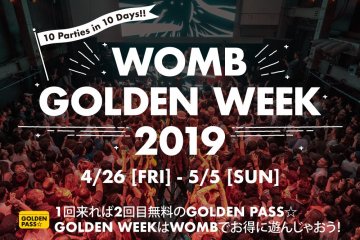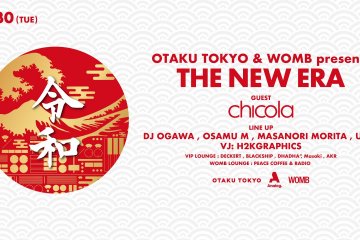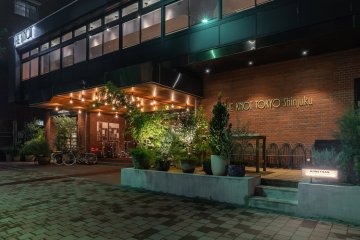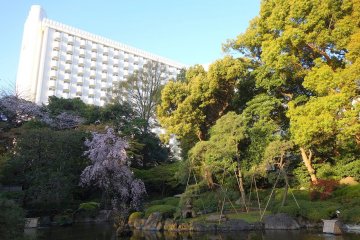
SOLOMUN at WOMB 2018
Ignatius KohPrepare your party mode and head down to Womb for LiLiTH, “the party #38”, on 21 April for a night of sensational house music and celebration.

Since its opening in 2000 in the heart of Shibuya—Tokyo’s epicenter of youth culture, fashion, and music—WOMB has established itself as one of the most influential electronic music clubs in the world. Far more than just a nightlife venue, WOMB is a driving force behind Japan’s thriving club scene and a cultural landmark that bridges local talent with the global electronic music community.
WOMB’s mission is clear: to deliver the freshest, most cutting-edge electronic music to fans in Tokyo and beyond. It regularly features international headliners while also championing the emerging sounds of Tokyo’s underground. The club’s main floor is renowned for its world-class sound system, immersive lighting, and striking laser visuals, offering a sensory-rich experience that rivals top clubs in cities like Berlin, London, and New York.
But WOMB is more than just its main stage. The club features three additional sub-floors, each with its own identity and vibe, offering a wide range of electronic subgenres and giving up-and-coming Tokyo DJs and producers a platform to shine. This variety makes WOMB not only a destination for established names, but also a vital launchpad for local artists aspiring to gain international recognition.
The club’s influence doesn’t stop at Tokyo’s borders. Through its global series, WOMB TOKYO NIGHT, the venue exports the energy and style of Tokyo nightlife to legendary venues around the world, including Fabric in London and Space Ibiza in Spain. These international events have helped position WOMB as a global ambassador for Japan’s club culture, attracting a loyal following of electronic music fans across continents.
WOMB’s global reputation is further cemented by its accolades in Mixmag, the renowned UK music magazine. It was ranked the #2 nightclub in the world in 2005, #5 in 2008, and #4 in 2009—recognition that reflects its consistent innovation and influence in the global scene.
Today, WOMB stands not only as a pillar of Tokyo’s nightlife, but as a cultural icon that blends the international with the local. It is a place where music, technology, and creative energy converge—a must-visit destination for any music lover seeking the true pulse of Tokyo’s dynamic electronic music landscape.
Even though you may find it slightly less impressive when you cross for yourself, the Shibuya Crossing is a must-visit spot for first-time visitors to Japan.
From House and Techno to Trance, K-Pop, and more, there really is a themed night—or floor—for whatever tunes get you up on your feet.
Also on the calendar are “Gay Mix” nights, bringing in internationally renowned DJs for a night of inclusive celebration. Joining the crowd are gogo dancers and drag queens, too!
The closest station to WOMB is Shibuya Station, possible to reach via many different lines. On the JR lines, there’s the Yamanote Line, Saikyo Line, and Shonan-Shinjuku Line; on the Tokyo Metro, there’s the Ginza Line, Hanzomon Line, and Fukutoshin Line; as for the private lines, there’s the Keio Inokashira Line, Tokyu Toyoko Line, and Tokyu Den-en-toshi Line. From there, it’s a 10-15-minute walk from the Scramble Square District Gate’s Central Exit to the lasers and luxury nightlife experience of WOMB.

Prepare your party mode and head down to Womb for LiLiTH, “the party #38”, on 21 April for a night of sensational house music and celebration.

Celebrate your Golden Week at Womb! Enter any of the Golden Week events and receive a free present of a GOLDEN PASS enabling you to party as much as you can!

This weekend it's time for New York’s legendary hard house DJ Danny Tenaglia to play at nightclub Womb! Starting in the early 90s he's one of the most influential dance music producers of our time, not least to mention that he's a Grammy-nominated record producer and has a number of international music awards under his belt.

On September 18th (Sunday, the day before the national holiday), "Discover. Tokyo", a new party combining fashion, culture, and music, launches its first event at WOMB! "Discover. Tokyo" is an LGBTQ+ friendly and gay music event welcoming all music lovers.

Celebrate your way into the new era of Reiwa with WOMB! An extravagant party including Confetti Cannon's will make sure you'll enter the new era in an unforgettable way.

Located right next to Shinjuku Chuo Park, THE KNOT TOKYO Shinjuku is a modern hotel with an exceptional design and easy access to the nearby Shinjuku train station and the Meiji Shrine. The 14-story hotel building was renovated and reopened in August 2018 as THE KNOT TOKYO Shinjuku . The western-style rooms offer a park view on the top floor as well as a newly opened terrace suite. The spacious atrium design offers a relaxed atmosphere and connects the restaurant, bar, lounge and lobby with one another. One of the highlights of THE KNOT is the delicious dishes. There are six areas in which food and drinks are offered. From the grill area to high-quality black tea and fresh bread, everything is on offer.

Just minutes from Shinagawa Station, the Grand Prince Hotel New Takanawa is surrounded by lush greenery in the Takanawa area, with rooms offering balcony views of the nearby gardens and the surrounding Tokyo cityscape. This urban resort features convention facilities like the Hiten banquet hall, the international Convention Center Pamir, as well as a wide variety of Japanese, Chinese and Western restaurants.

ANA Holiday Inn Tokyo Bay (previously Dai-ichi Hotel Tokyo Seafort) is a 132-room hotel that will provide visitors to Japan’s capital city with an attractive, fresh option in the midscale space. ANA Holiday Inn Tokyo Bay will join a strong portfolio of 10 ANA Holiday Inn open and pipeline hotels across Japan, and become part of the brand’s global footprint of 1,234 open hotels and 278 pipeline properties.

Mame Shiba Cafe offers a unique experience where you can interact with Shiba dogs while enjoying your favorite drinks. You cannot make reservations in advance through phone or online, so it is best to book early in the morning at a store. The cafe requires customers to make a reservation in-store, present their receipt at the reserved time, and then enter the cafe.

B-Flat Commune is an open-air hangout in Omotesandō featuring a variety of stalls and food trucks offering unique drinks, clothing, and bites to eat. Its relaxed vibe and plenty of seating make it an ideal spot for casual meetups and spending time with friends. It's a creative place where people can gather to eat a the open-air dining space or purchase fashion, antiques, product goods and other lifestyle items. Events are sometimes hosted at this community space, and operating stores may change from month to month.

If you're a fan of Quentin Tarantino’s Kill Bill, there's one Tokyo restaurant that absolutely deserves a spot on your bucket list. While you may not know it by its real name, chances are you've seen it on screen—it’s the unforgettable setting for the iconic, over-the-top showdown between The Bride and the Crazy 88. Known affectionately by fans as “The Kill Bill Restaurant,” this venue offers more than just cinematic nostalgia—it's a vibrant and unique dining experience in its own right. Located in Tokyo’s upscale Nishi-Azabu district, this classic-style izakaya bar is where fiction meets flavor. Though the fake blood and samurai swords have long been cleaned away, the spirit of the film lives on in the architecture and atmosphere. Stepping inside feels like walking onto the set: a grand, high-ceilinged hall with a central open-plan dining space, surrounded by a mezzanine-level balcony—instantly recognizable to anyone who’s watched the movie. But don’t mistake it for just a movie-themed attraction. The Kill Bill restaurant is a serious culinary destination. It offers a wide variety of traditional Japanese dishes, from sashimi and grilled skewers to noodle dishes and seasonal specialties. The menu also boasts creative fusion items like avocado and camembert tempura, which nods to the restaurant’s global popularity and mindset. And for international travelers with specific dietary needs, the restaurant provides vegan and halal-friendly menus (with at least three days’ notice). What makes this spot truly special is its ability to deliver a top-tier gourmet experience while doubling as a pop culture pilgrimage. You can sip sake where Uma Thurman once sliced through waves of enemies—minus the chaos, of course. Whether you’re a die-hard Tarantino fan, a foodie on the hunt for authentic Japanese flavors, or simply someone looking for a unique night out in Tokyo, this restaurant checks every box. Just one tip: Enjoy the drinks and dishes, but leave the swordplay to the professionals. Note: As you’d expect, Gonpachi is a popular restaurant. Same-day reservations are possible, but ideally you’ll want to reserve your table at least two days ahead of your visit, and even earlier if you’re planning to visit at the weekend.

The familiar bronze statue of Hachiko stands right outside the Hachiko exit of Shibuya Station, near the world‑famous Shibuya Scramble Crossing—often dubbed the busiest pedestrian crossing in the world. It’s now a beloved meeting spot and local landmark, borne of a tear-jerking true story. Hachiko was an Akita dog born in 1923 in Akita Prefecture and later adopted by Professor Hidesaburo Ueno in Tokyo. The pair shared a heartwarming routine: each day, Hachiko would walk Ueno to Shibuya Station and wait for his return. Tragically, Ueno passed away suddenly in 1925, but Hachiko continued to wait at the station every evening for nearly ten years—until his own death in 1935. To honor this decade-spanning tale of loyalty, a bronze statue sculpted by Teru Ando was unveiled at the station in 1934, with Hachiko himself present. During World War II, the original was melted down, but a replacement by the artist’s son, Takeshi Ando, was erected in 1948 and remains to this day. Though this spot remains the most famous Hachiko Statue, there are a number of Hachiko sculptures in Tokyo, with the University of Tokyo’s Hachiko Statue portraying a touching reunion between the faithful Akita and his beloved owner. As you’ll see, Hachiko’s bronze legs are worn down to a dull shine by decades of visitors reaching out, perhaps hoping to get a glimpse into a relationship so pure and strong that it has touched the hearts of people even 100 years later. Bonus tip: If you're visiting on April 8, look out for a special ceremony at the statue honoring Hachiko’s memory. It’s a heartfelt moment that often includes flower offerings and local speeches.

The Shibuya Fukuras building, which opened in November 2019, is the latest in a series of skyscrapers that are part of the Shibuya skyline and define the central cityscape. The building, which is designed for both Japanese and international visitors, houses offices, retail stores (operated by Tokyu Plaza Shibuya), a bus station for local and airport buses, luggage storage rooms and tourism information facilities. It is located in the Dogenzaka area of Shibuya and will be even more accessible thanks to the planned deck that will connect the Shibuya Fukuras skyscraper directly to Shibuya station in the future. With 18 above-ground and four underground floors, there is a lot to discover here!

Shibuya Loft, the largest Loft in Tokyo is a 7 floor store and a common place to shop for gifts. The store is tax free and visitors who show their foreign passport upon check out will receive a 5% discount when spending a certain amount. Loft is a Japanese chain selling everyday commodities such as gifts, stationary, art, cosmetics and houseware.